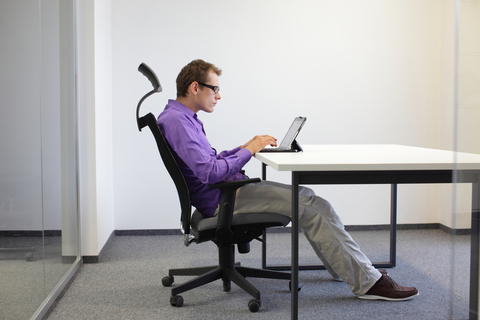We see it all around us, gazing at co-workers strapped to chair and computer, hunched like Ebenezer Scrooge. There is a surge of esthetic vanity as we vow to never let it happen to ourselves, but then, slowly over time, traveling below our radar, it does. We look in the mirror one day, or see a picture or ourselves, or start to have some neck pain that no longer goes away after a weekend free from the desk. The 10, 20, 30 years at a desk has caught up with us, we’re starting to resemble the hunchback from Notre Dame.
Some Americans are sitting on average 15 hours a day and since life at a computer or electronic device will not soon go away, this is an issue to be reckoned with. Unfortunately, it’s not only electronic devices that are the culprit, how we posture ourselves driving the car, eating dinner and watching the kids at a soccer game play a role in this predicament as well.
What’s the problem?
- Improper seating leads to inadequate support of the torso and subsequently the head and arms leading to postural muscular overuse and fatigue.
- This forces the body to leverage bone/joints to maintain proper posture.
- Prolonged loading of bony structure ultimately leads to pain and wearing of cartilaginous and bony surfaces; this can be accelerated if there has been an incident of significant trauma (macro trauma) i.e. car accident in conjunction to the daily overuse (micro trauma)
- With increased joint pain, the already fatigued musculature tightens even more aggressively in attempt to protect the adjacent painful joint structure only leading to greater soft tissue pain.
- The inability of regional postural musculature to do its normal job due to hyper tonicity pain and progressive weakening leads to greater loading of bony/joint structure because daily postural demands don’t change only to create more bony/joint based pain.
The cycle perpetuates in a downward spiral
What are the symptoms?
- Neck pain at the base of the skull and resultant headache thereof.
- Pain at the juncture of the neck and upper back “Dowager’s Hump”
- Pain in the mid back and along the top and medial sides of the shoulder blades
- Pain along the beltline after prolonged sitting
- Pain that used to resolve later in the evening, then by mid weekend, then regressing to constant symptoms including sleep impairment.
- Functional motion loss; “Can’t turn my head anymore to back the car out of the driveway”. “Can’t sit thru a movie due to back and neck pain”.
But it’s so hard to do all of my postural exercises, I just need a queue to help me stand up straight (which will engage and strengthen postural muscles as well).
The easy answer: watch your thumbs…
Relative position of your thumbs as you stand erect (or seated in a chair with arms at side) directly correlates with scapular and thoracic spine position which plays a direct role in positioning of the head and neck. The more the thumbs point forward in an erect posture the more neutral the scapula and thorax and subsequently the head and neck, greatly reducing stress to bony and soft tissue structure.with scapular and thoracic spine position which plays a direct role in positioning of the head and neck. The more the thumbs point toward each other, the more rounded and protracted the upper thoracic spine and scapula which subsequently projects the head forward, thus placing more mechanical stress at the juncture of the cervical and thoracic spine. A head weighs between 10-15 pounds and is thus obviously a large load to carry and the further it migrates forward during the day, the more “micro” trauma that occurs.
“It’s time to get your body back”
- Staying Fit While Aging - July 3, 2023
- How Much Exercise do You Need to Stay Healthy? - September 21, 2022
- Even a Small Amount of Exercise can Have Huge Benefits for Our Bodies - March 16, 2022

